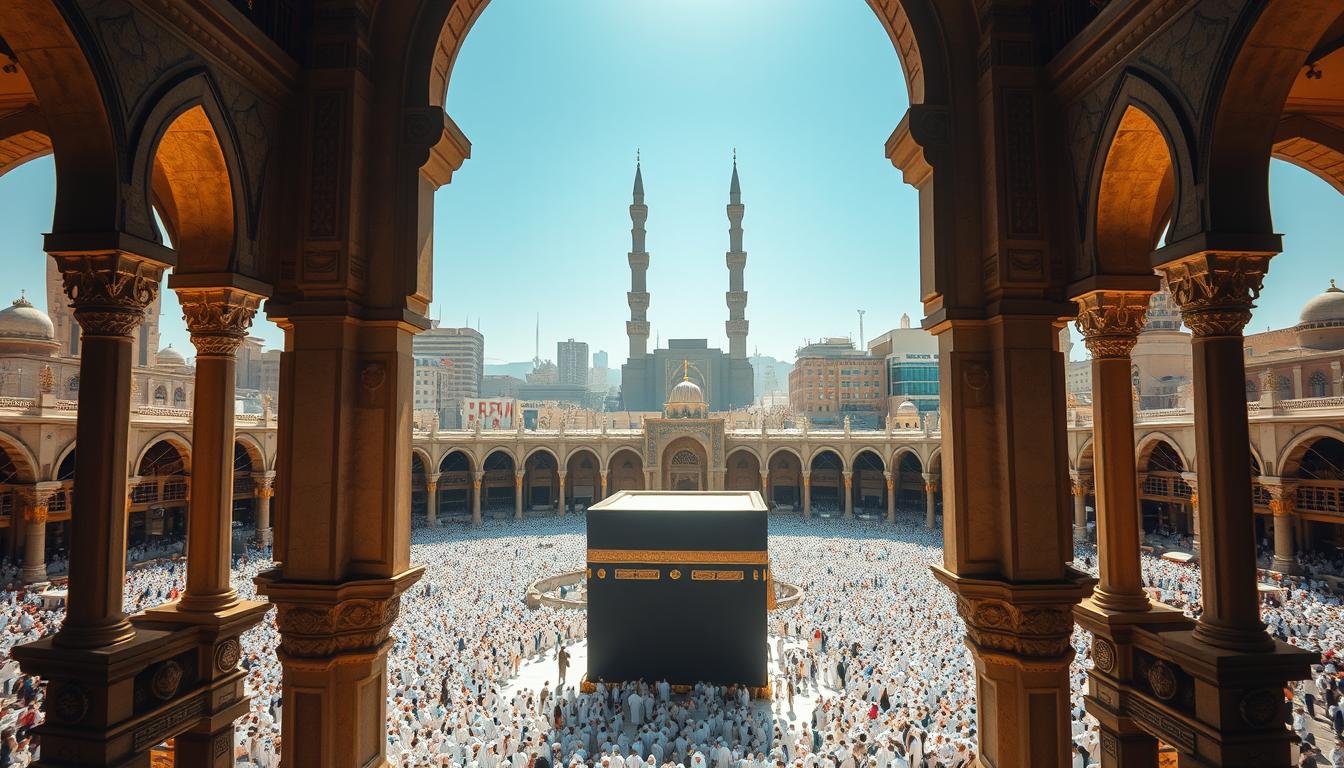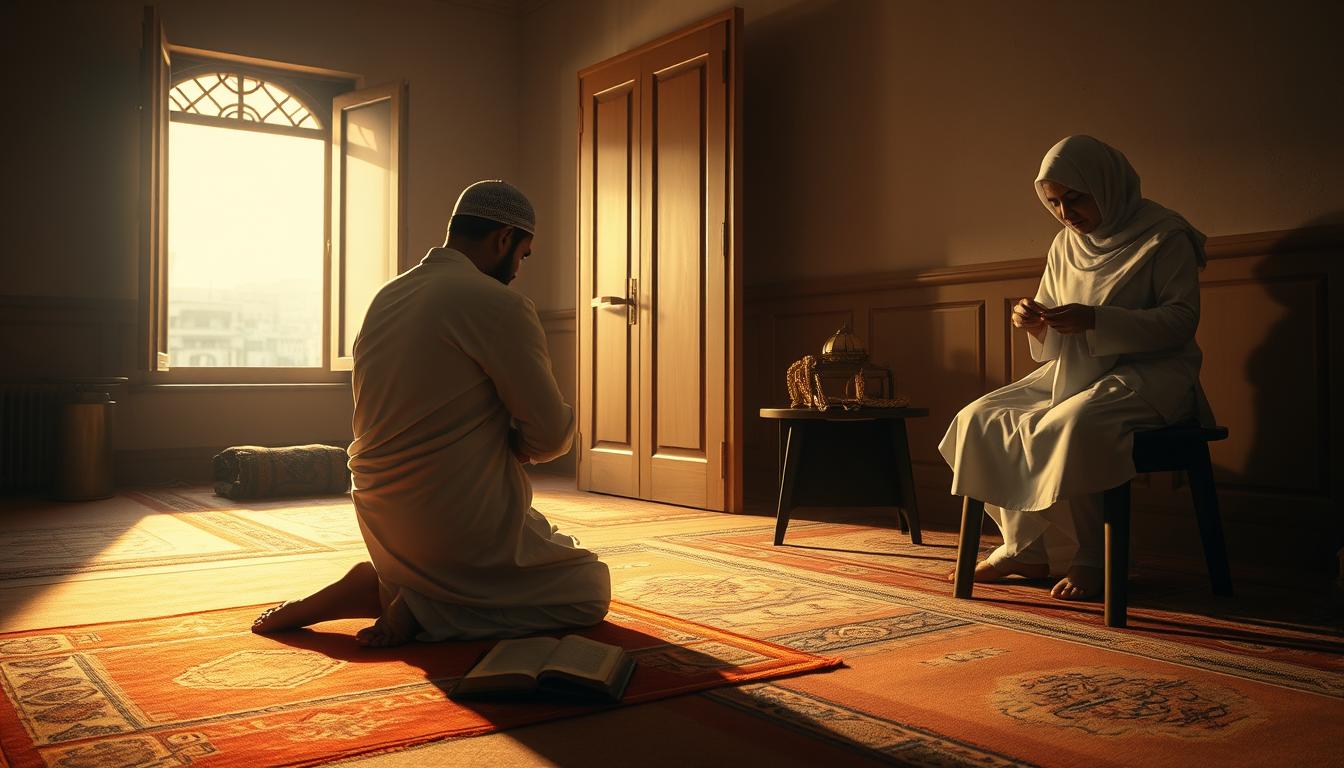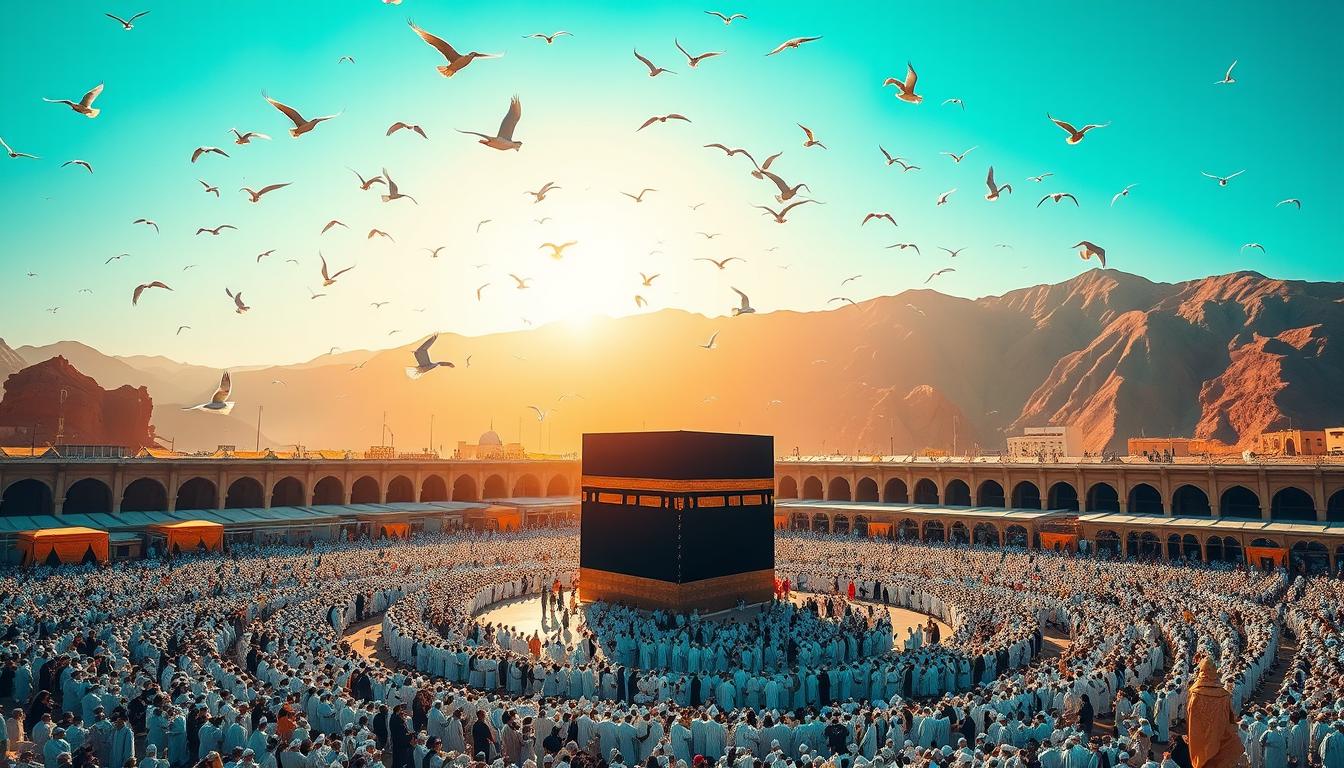Have you ever wondered about the spiritual journey of Hajj for Muslims worldwide? What is Hajj in Islam? For millions, Hajj is a once-in-a-lifetime pilgrimage that shows the heart of their faith.
As we look into the Islamic pilgrimage, we’ll see its rituals and spiritual practices. Hajj is more than a trip; it’s a deep show of devotion and unity among Muslims everywhere.

Knowing the Hajj definition helps us understand its role in Islam. It’s a journey that needs a lot of physical and spiritual effort. It shows the unity and solidarity of the Muslim community.
Key Takeaways
- Hajj is a significant pilgrimage in Islam, representing a once-in-a-lifetime obligation for Muslims.
- The journey involves various rituals and spiritual practices that embody the faith.
- Hajj symbolizes unity and solidarity among Muslims worldwide.
- It’s a profound expression of devotion, requiring considerable physical and spiritual effort.
- The Islamic pilgrimage is a cornerstone of Islamic faith and practice.
The Spiritual Significance of Hajj
Hajj is a key part of Islamic practice, filled with deep spiritual meaning. It’s a journey that shows the heart of Islamic faith and practice. It’s a big commitment for Muslims all over the world.
The Fifth Pillar of Islam
Hajj is the fifth pillar of Islam, a key part of the faith. It’s a journey every Muslim must take once in their life if they can. The spiritual significance of Hajj is in bringing Muslims together. It makes them feel united and equal.
Historical Origins of Hajj
The historical origins of Hajj go back to Prophet Ibrahim (Abraham) and his son Ismail (Ishmael). They are said to have built the Kaaba in Islam. The rituals of Hajj connect to their story, showing faith, obedience, and sacrifice.
Looking into the spiritual and historical sides of Hajj helps us see its big impact on Muslims. Going to the Kaaba is more than a physical trip. It’s a spiritual journey showing a Muslim’s dedication to their faith.
What is a Hajj in Islam: A Comprehensive Definition
Exploring Hajj means understanding its definition and religious importance. It’s not just a trip; it’s a spiritual refresh and a sign of unity among Muslims.
Etymology and Meaning
The word “Hajj” comes from “hajja,” which means “to go to a place” or “to attend.” In Islam, Hajj is the journey to the Sacred House in Mecca. It’s a trip every able-bodied Muslim must make at least once in their life.
Religious Obligation and Requirements
Hajj is a key part of Islam, one of the Five Pillars. To go on Hajj, a Muslim must be physically and financially ready. This means being mentally sound, able to afford the trip, and physically fit for the rituals.
Spiritual Transformation Through Hajj
Hajj is more than a physical trip; it’s a spiritual journey. It’s a chance for Muslims to ask for forgiveness, strengthen their faith, and come back with a new purpose. Through Hajj’s rituals, pilgrims deeply connect with their faith and community.
Who Must Perform Hajj: Requirements and Exemptions
Hajj is a key part of Islam. It’s a big deal for those who qualify. Certain rules decide who must go on this holy trip.
Financial Capability (Istita’ah)
Having enough money is key for Hajj. This means you need cash for travel, staying, and other costs. You should be able to do Hajj without hurting your family’s finances.
| Financial Requirements | Description |
|---|---|
| Travel Expenses | Costs for going to Mecca |
| Accommodation | Costs for where to stay during Hajj |
| Other Expenses | Extra costs like food and getting around |
Physical Health Requirements
Your health matters a lot. You need to be fit for Hajj’s tough parts, like Tawaf and Sa’i. You must be strong enough to handle the crowds and do the rituals.
Exemptions and Alternatives
Not everyone must go to Hajj. Some people can’t because of health or money issues. For those who can’t do Hajj, there’s
In short, going to Hajj depends on money, health, and personal situations. Knowing these rules helps Muslims figure out if they must go on this important Islamic pilgrimage.
Preparing for Hajj: Essential Steps
Getting ready for Hajj is a big job. It needs spiritual, financial, and physical steps. We must be ready for a meaningful journey.
Spiritual Preparation
Being spiritually ready is key for a good Hajj. It includes a few important steps:
Seeking Knowledge About Hajj
Knowing the Hajj rituals is vital. Pilgrims should learn about hajj pilgrimage rituals like Tawaf and Sa’i.
Repentance and Resolving Conflicts
It’s good to seek forgiveness and fix any issues before going. This makes the journey more focused.
Financial Planning
Planning your money is crucial for Hajj. You need enough for travel, staying, and other costs. Making a budget helps avoid money worries.
Physical and Health Preparations
The Mecca pilgrimage is hard work. So, getting fit is important. This includes:
- Regular exercise to build strength.
- Doctor visits, especially for health issues.
- Staying up to date with shots.
Knowing the hajj meaning makes the journey better. Preparing well ensures a great Hajj experience.
| Preparation Aspect | Key Activities |
|---|---|
| Spiritual Preparation | Seeking knowledge, repentance, resolving conflicts |
| Financial Planning | Budgeting, saving, covering expenses |
| Physical and Health Preparations | Exercise, health check-ups, vaccinations |

The Sacred Journey to Mecca
The journey to Mecca is more than a trip. It’s a spiritual journey that needs devotion and commitment. As we head to the heart of Islam, we feel reverence and excitement.
Travel Logistics and Requirements
Going to Mecca for Hajj requires careful planning. We must have the right documents, like a valid passport and Hajj visa.
Visa and Documentation
Getting a Hajj visa needs work with travel agencies or governments. Our passports must be good for at least six months after we come back.
Traveling with a Group or Tour
Many choose to travel with a group or tour. It makes things easier and offers support on the journey.
Entering the State of Ihram
As we near the Miqat, we get ready to enter Ihram. We wear special clothes and follow certain rules.
Ihram Clothing and Restrictions
Ihram clothes are simple and the same for everyone. Men wear two white, seamless sheets. Women wear modest clothes that cover their body.
Miqat: Designated Entry Points
Miqat are special places where pilgrims enter Ihram. These spots are important and mark the start of Ihram.
By following these steps, we can have a meaningful Hajj experience.
The Five Days of Hajj: A Step-by-Step Guide
Hajj is a five-day journey to Mecca. It includes rituals that are key to Islamic faith. These days show the deep meaning of Hajj and its effect on pilgrims.
Day 1: Tawaf and Sa’i
The first day starts with Tawaf. Pilgrims walk around the Kaaba seven times. This shows unity and devotion to Allah. Then, they do Sa’i, walking between hills seven times. This remembers Hagar’s search for water for her son Ismail.

Day 2: Standing at Arafat
The second day is the most important. Pilgrims go to Arafat for Wuquf, or standing in devotion. It’s a time to think about the Day of Judgment and seek forgiveness.
Day 3: Muzdalifah and Stoning of the Jamarat
On the third day, pilgrims go to Muzdalifah. They spend the night there, collecting pebbles. These pebbles are used for Rami al-Jamarat, a ritual that rejects evil.
Days 4-5: Final Rituals and Farewell Tawaf
The last days finish the Hajj rituals. This includes the Farewell Tawaf, saying goodbye to the Kaaba. Other rituals follow, ending the pilgrimage.
| Day | Rituals | Significance |
|---|---|---|
| 1 | Tawaf and Sa’i | Unity and devotion to Allah; commemorating Hagar’s search for water |
| 2 | Standing at Arafat | Reminder of the Day of Judgment and seeking forgiveness |
| 3 | Muzdalifah and Stoning of the Jamarat | Rejection of evil and spiritual cleansing |
| 4-5 | Final Rituals and Farewell Tawaf | Conclusion of Hajj; bidding farewell to the Kaaba |
The Kaaba: The Sacred House of Allah
The Kaaba is a key site in Islam. It’s the center of Hajj rituals, showing Muslims’ unity and devotion. Located in Mecca, it’s a cube-shaped House of Allah. Muslims face it during daily prayers.
Historical Significance of the Kaaba
The Kaaba’s history goes back to Prophet Abraham and his son Ishmael. They built it. It’s a symbol of monotheistic worship and a key part of Islamic pilgrimage.
Tawaf: Circumambulation Around the Kaaba
Tawaf is a major Hajj and Umrah ritual. It involves walking around the Kaaba seven times. This act shows Muslims’ unity and devotion to Allah.
Types of Tawaf
There are different Tawaf types. These include Tawaf al-Qudum (arrival), Tawaf al-Ifadah (after Arafah), and Tawaf al-Wada (farewell). Each has its own importance in the pilgrimage.
Prayers and Supplications During Tawaf
During Tawaf, pilgrims say prayers and supplications. They seek forgiveness and blessings from Allah. They recite Takbir (Allahu Akbar) and Tahlil (La ilaha illallah). This strengthens their spiritual bond with the divine.
Essential Rituals of Hajj Explained
The Hajj pilgrimage is a deep spiritual journey. It includes several key rituals. These rituals are very important for the Hajj and Islam.
Ihram: The Sacred State
Ihram is a special state for Hajj pilgrims. They wear certain clothes and avoid some activities. It shows unity and equality among them.
Everyone wears the same simple clothes, no matter their status. By entering Ihram, pilgrims show they want to perform Hajj and seek spiritual purity.
Sa’i: The Walk Between Safa and Marwah
Sa’i is walking between Safa and Marwah hills. It remembers Hagar’s search for water for her son Ismail. This ritual shows faith, perseverance, and God’s care.
As pilgrims walk, they think about Hagar’s story. It has deep spiritual meaning for them.
Wuquf: Standing at Arafat
Wuquf is standing at Arafat. Pilgrims gather here, seeking forgiveness and mercy from Allah. It’s the Hajj’s peak moment.
Here, pilgrims pray and think about their actions. Wuquf at Arafat is like Judgment Day, showing the need to seek forgiveness.
Rami al-Jamarat: Stoning the Pillars
Rami al-Jamarat is stoning three pillars. It shows rejecting evil and the devil’s temptation of Prophet Ibrahim. This ritual honors Prophet Ibrahim’s actions.
By stoning the pillars, pilgrims show they resist evil and follow the right path.
Common Challenges During Hajj and How to Overcome Them
Millions of pilgrims go to Mecca for Hajj. It tests their physical, emotional, and spiritual strength. The journey is rewarding but comes with challenges that need preparation and resilience.
Physical Challenges and Health Concerns
Hajj is very physically demanding. Pilgrims face travel, crowds, and rituals that need lots of effort.
Heat Exhaustion and Dehydration
Heat exhaustion and dehydration are big risks in Saudi Arabia’s heat. Stay hydrated, wear right clothes, and rest when needed.
Foot Care and Mobility Issues
Walking a lot in Hajj means foot care is key. Wear comfy shoes and bring foot care items.
| Health Concern | Precautionary Measures |
|---|---|
| Heat Exhaustion | Stay hydrated, rest in shaded areas |
| Dehydration | Drink plenty of water, avoid strenuous activities during peak heat |
| Foot Care | Wear comfortable shoes, bring foot care supplies |
Navigating Large Crowds
Dealing with big crowds in Hajj is tough. Stay with your group, follow rules, and be patient.
Emotional and Spiritual Challenges
Hajj’s emotional and spiritual sides can be hard. Feelings range from joy to worry. Dua (supplication) and staying connected with loved ones help.
Knowing these challenges and being proactive makes Hajj more meaningful and less stressful.
The Transformative Impact of Hajj on a Muslim’s Life
The Hajj pilgrimage changes a Muslim’s life in big ways. It’s not just a duty but a personal and group experience. It leaves a mark on those who go.
Spiritual Renewal and Purification
Hajj is about spiritual renewal and cleaning. Muslims reaffirm their faith and seek forgiveness. Circling the Kaaba shows unity and connection with others.
This spiritual refresh is key to the hajj meaning. It’s about going back to Islamic faith’s roots.
Social and Community Impact
The hajj significance goes beyond the individual. It brings Muslims together, showing unity and equality.
Unity and Brotherhood
In Mecca, Muslims from all over unite. The islamic pilgrimage mixes cultures, languages, and backgrounds. It creates a global Muslim identity.
Lessons Carried Home
After Hajj, people bring back lessons for daily life. They return with a new purpose and commitment to their faith and community.
| Aspect of Hajj | Spiritual Impact | Social Impact |
|---|---|---|
| Tawaf (Circling the Kaaba) | Reaffirms faith and unity with Allah | Fosters a sense of community among pilgrims |
| Standing at Arafat | Seeking forgiveness and mercy | Equality and unity among diverse pilgrims |
| Sa’i (Running between Safa and Marwah) | Reflects on the story of Hagar and her faith | Encourages perseverance and patience |

Umrah vs. Hajj: Understanding the Differences
It’s important for Muslims to know the difference between Umrah and Hajj. Both are sacred trips to Mecca. But they have different times, rules, and spiritual meanings.
Timing and Obligation
Hajj happens once a year in Dhu al-Hijjah, from the 8th to the 13th day. It’s a must for those who can do it. Umrah, on the other hand, can be done anytime and is not required, but it’s very encouraged.
Rituals and Requirements
Both pilgrimages include Ihram, Tawaf, and Sa’i. But Hajj has more, like standing at Arafat and Muzdalifah, and stoning the Jamarat. Umrah is simpler and takes less time.
Spiritual Significance
Both Umrah and Hajj are very spiritual. They offer chances for forgiveness and renewal. Hajj is a key part of Islam and must be done once in a lifetime for those who can.
| Pilgrimage | Timing | Obligation | Main Rituals |
|---|---|---|---|
| Hajj | Dhu al-Hijjah | Obligatory | Tawaf, Sa’i, Arafat, Jamarat |
| Umrah | Anytime | Recommended | Tawaf, Sa’i |
Conclusion: The Enduring Legacy of Hajj in Islamic Faith
The Hajj pilgrimage is very important in Islam. It shows unity, equality, and devotion to Allah. The hajj significance goes beyond the rituals, being a personal and spiritual journey for Muslims everywhere.
The Kaaba in Islam is key, a central point for Muslims during the islamic pilgrimage.
By doing Hajj, Muslims strengthen their faith. They seek spiritual renewal and a closer bond with their community. This journey changes them, bringing unity and shared goals.
As we finish talking about Hajj, its impact is clear. It deeply affects Islamic faith and practice, changing the lives of Muslims globally.
Hajj’s legacy inspires and guides Muslims. It reminds them of their faith’s values and principles. As a journey of spiritual discovery and community bonding, Hajj is crucial to Islamic identity. It makes the lives of those who go on this sacred journey richer.
FAQ
What is the significance of Hajj in Islam?
Hajj is a key part of Islam. It’s a journey of spiritual growth and self-reflection. Muslims come together to worship and seek forgiveness.
What are the requirements for performing Hajj?
To perform Hajj, one must be physically and financially able. This means having the resources and being in good health.
What is the difference between Hajj and Umrah?
Hajj happens in Dhu al-Hijjah. Umrah can be done anytime. Hajj is more significant and obligatory, while Umrah is voluntary but still very meaningful.
What is the significance of the Kaaba in Hajj?
The Kaaba is the House of Allah. It’s the heart of Hajj. Circumambulating around it is a ritual that shows unity and devotion.
What are some common challenges faced during Hajj?
Challenges include physical and health issues, dealing with crowds, and emotional and spiritual struggles. Pilgrims should prepare and take precautions for a meaningful experience.
What is the spiritual significance of standing at Arafat during Hajj?
Standing at Arafat is a key ritual. It’s where pilgrims worship and seek forgiveness. It’s a powerful reminder of the Day of Judgment and seeking Allah’s mercy.
How does Hajj promote unity and brotherhood among Muslims?
Hajj unites Muslims from all over. It fosters unity and brotherhood. The shared Hajj experience creates a sense of solidarity among Muslims worldwide.
What is the significance of Ihram during Hajj?
Ihram is a sacred state before Hajj. It’s marked by simple, white clothing. Ihram represents purity, equality, and devotion to Allah, essential for the Hajj experience.


